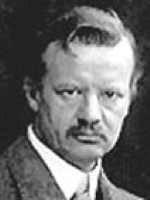
1935 Nobel Prize in Physiology or Medicine
Hans Spemann (*1869 – †1941) received the Nobel Prize for his discovery of the organizer effect in embryonic development.
Hans Spemann, born on 27 June 1869 in Stuttgart, initially followed in the footsteps of his father, publisher of a well-known series of children’s books called Neues Universum. In 1891 he began studying medicine in Heidelberg. After passing the preliminary medical examination he changed his major to natural sciences and continued his studies in Munich, where cellular biologist Theodor Boveri, a friend of Wilhelm Conrad Röntgen, became his dissertation supervisor and mentor.
Upon completing his dissertation on developmental stages of parasitic worms, Spemann chose to focus on the embryonic development of amphibians (newts) as his principal area of research. He began by describing the internal structure of various develomental stages of newts and then developed new microsurgical procedures to study the mechanisms governing their embryonic development. His first experiment on this topic, his “hair twins” (1901), earned him widespread recognition. By tying a loop of baby hair around an ovum, Spemann succeeded in producing two smaller but complete larvae from a single ovum!
In the following years, Spemann accepted professorships in Rostock (1908), Berlin (1914), and Freiburg (1919). In 1921, he discovered in numerous experiments conducted with his doctoral student Hilde Mangold that a small piece of tissue from a certain area of the ovum can “organize” the generation of secondary embryonic primordia when implanted in the future region of the stomach! The discovery of the so-called “oragnizer effect” earned Spemann the Nobel Prize in 1935. Hilde Mangold, with whom Spemann would have certainly shared the prize, had died in an accident years before.
In later years, Spemann successfully extended this transplantation technique to other regions of the embryo together with Otto Mangold, thus sparking an international wave of new research in embryonic development. In the decades following his death (1941) his renown faded somewhat due to the biochemical orientation of those years, but the rise of molecular biology has led to an unprecedented renaissance in the reception of his work since the mid 1970s.







